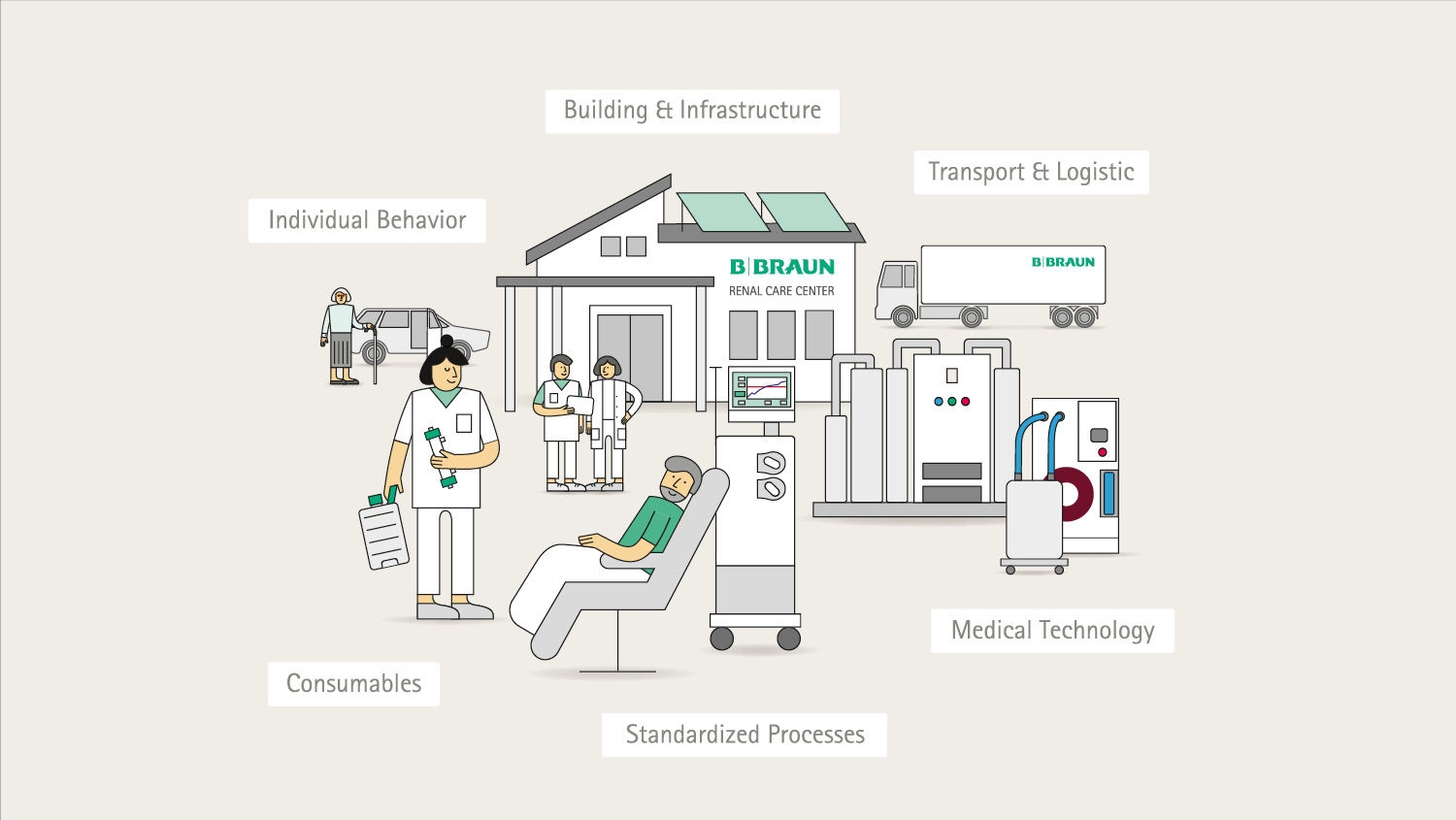No content results match your keyword.
Content
You have successfully logged out.
Not registered yet?
Our shared responsibility
Hemodialysis is a life-sustaining therapy.1,2 At the same time, the environmental impact of dialysis therapy seems to be particularly high.3 It consumes a significant amount of water and energy and produces a high amount of waste and CO2 emissions.4 There are ways to reduce this environmental burden: by rethinking processes, products and technologies, building infrastructure, logistics and individual behaviors we can make dialysis more sustainable together – without compromising patient care. At B. Braun, we offer products and solutions supporting you to make a difference. It is time to rethink dialysis therapy towards a more sustainable and environmental conscious future.

Approx.
0
million m3 of fresh water annually are consumed by hemodialysis treatments in Europe.5 To put this into perspective, this is roughly equivalent to 4,958 Olympic pools/year or 13.5 Olympic pools/day.[6]
Approx.
0
MWh per year is the estimated European energy consumption for hemodialysis.5 This amount of energy could power a city of approximately 74,847 Dutch families (average Dutch family of five people consumes 4,371 kWh/year).6
Approx.
0
tons of waste annually is generated by hemodialysis in Europe.5 This is the weight equivalent of roughly 10,458 elephants (adult male elephant 6,000 kg).6
Toward more sustainable kidney care
Healthcare services are necessary for sustaining and improving human well-being.2 If the global healthcare sector were a country, it would be the fifth-largest greenhouse gas emitter on the planet.7 Compared to other fields of medicine, the environmental burden of dialysis is disproportionately high. In fact, dialysis is one of the most resource-intensive fields of medicine. Consequently, kidney care can play a crucial role in advancing toward more sustainable healthcare practices.8 This is the essence of Green Dialysis.
Our understanding of Green Dialysis is to decrease the environmental burden of dialysis therapy, for example by taking measures to reduce the consumption of energy and water, the amount of waste and the emission of CO2 – without compromising the medical quality of the hemodialysis treatment.


Different areas have been identified where actions can be taken to make dialysis more sustainable in daily practice:
In each of these areas, numerous possibilities for improvement exist. It is essential to first assess the current environmental status of each renal care center individually. This evaluation will help with identifying and implementing practical measures to enhance sustainability in daily practice. A wealth of information and possible measures can be found in literature5 and initiatives, such as Green Excellence in Dialysis recommendations for sustainable kidney care by EDTNA/ERCA, published in September 2022.9
Hemodialysis comes with high resource demands. On average each session uses around 477 liters of water and 12.6 kWh of energy.5
Find out how modern water treatment systems can help reduce this footprint and operational costs.
Dialysis is one of the biggest waste producers in medicine. Each session can generate up to 8 kilograms of waste.11 What we throw away matters. And how we manage it matters even more.
Let us rethink how we separate, reduce, and choose — because every product, every decision, and every step counts.
Dialysis treatment not only negatively impacts our environment, but climate change is assumed to affect global health, including chronic kidney disease (CKD) as well. Several factors can contribute to the increasing prevalence of CKD due to climate change. Rising global temperatures lead to more cases of heat-related kidney injuries.12 In addition, extreme weather events can disrupt healthcare services, resulting in inconsistent treatments. Climate change also affects the spread of diseases that can impact kidney health, increasing the number of patients requiring dialysis.13
When we act with generations of today and tomorrow in mind, we turn today’s choices into tomorrow’s opportunities to protect and improve the health of people around the world.


At B. Braun, sustainability has long been a company value, and we are committed to shaping a more sustainable future in dialysis. We collaborate with experts and actively contribute to initiatives like the EU-funded KitNewCare project and the EDTNA/ERCA Green Excellence in Dialysis project. As a provider of more than 350 renal care centers worldwide, we recognize the environmental impact of hemodialysis — and we are taking actively steps to reduce it.
Learn moreYou will be contacted by a Green Dialysis Expert. Kindly check your inbox and confirm the e-mail we've sent you.
Your feedback matters! Participate in our customer survey to help us enhance our website, products and services. Thank you for your support!